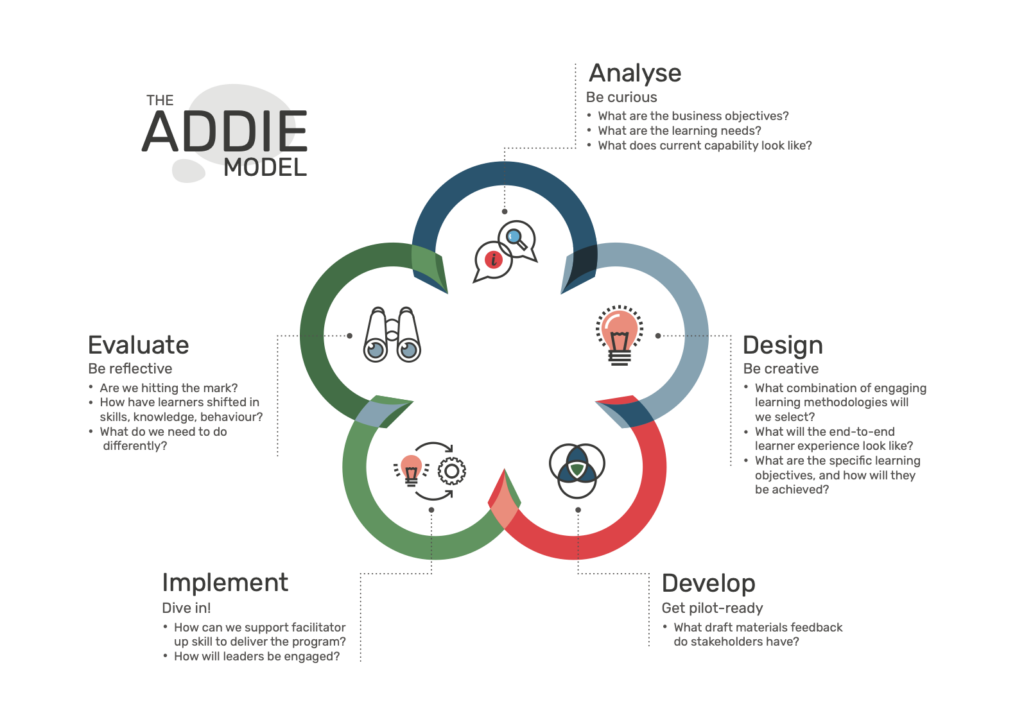The Instructional Design Method
Our Approach to Instructional Design
We follow the ADDIE instructional design method.
The Instructional Design Consultant can be asked to complete the entire process from the Analysis through to the Evaluation or they can be asked to do just one or two parts of the instructional design method. If a client has already determined what they need and defined the objectives then the Instructional Designer can start at the Design phase. On occasions, the client wants to develop the product on their own so the Instructional Designer may do just the Design phase. However, a skilled Instructional Designer can carry out the entire process when required.
This instructional design method is a nonlinear sequence. The oval background depicts the ability to return to previous phases or jump ahead to later phases.
E.g. 1 When defining the objectives, you might need to do more analysis.
E.g. 2 When designing, you are always referring back to the objectives.
E.g. 3 If you find an error when you are carrying out the testing, you may need to go back to the design and development phases.
Learning Methodologies and Activities
We use a variety of adult learning theories in our learning design. Our approach is driven by the concept of inquiry-based discovery learning, which requires learners to make connections to previous knowledge, bring their own questions to learning, investigate and critically reflect on concepts and design ways to try out their ideas.
To maximise learner engagement and transfer of learning, we design programs that offer both formal and informal learning opportunities.
Examples of methodologies and activities that we use when designing effective learning solutions include:
|
|
Our Approach to eLearning
Once the ‘Analyse’ phase of the ADDIE model is complete, we typically ‘chunk’ eLearning projects into six stages.
Stage 1: Real time – High Level Design (HLD)
We will build a ‘skeleton’ course based on the source material provided. This will form the HLD, which allows you to understand the proposed flow and structure of the course. You will be invited to provide input via our eLearn build website, phone or Zoom meeting.
We will require an initial meeting before commencing this stage to ensure a shared understanding of the process and to explore how to ‘chunk’ the program into sections. In this meeting, there will be an initial conversation around any proposed videos, case studies, scenarios or branching scenarios you wish to be included.
Stage 2: HLD review and resource-gathering meeting
During this stage, we:
- Ensure that the HLD meets requirements
- Walk through any proposed new content and changes
- Seek client advice around assessment or knowledge check requirements
- Collect other data and information
- ‘Flesh out’ proposed videos, case studies, scenarios or branching scenarios (where required)
This will capture all information and resources required to build the course.
We envisage that we will need approximately 2.5 hrs with SMEs and potentially a further series of meetings to both ensure the suitability of the course structure and to capture the requirements for any new content or changes.
Stage 3: Draft course build
We will create a draft version of the course by ‘building out’ the HLD. This is where you will see the eLearning course come to life.
Stage 4: Draft course review
We will walk through the course with you and make required adjustments and enhancements. We anticipate that this meeting will take approximately 1 to 2 hours. We will give you further time to review your course independently. You will be able to provide feedback into our eLearning tool in a similar way to ‘comments’ on MS Word. This saves time by ensuring that we know exactly where feedback is directed.
We will action any feedback – two rounds of feedback and edits are generally allowed for in proposal costing.
Stage 5: Finalise and handover
We will publish the eLearning course in your choice of SCORM-compliant file and complete a final quality check. We’ll also provide an editable file to allow you to make changes in the future if desired. If required, we can liaise with your Learning Management System (LMS) Administrator to assist in determining the best format for course publication.
Stage 6: Post-handover support
We can provide ongoing support to ensure that your program is a success.
We can:
- Help to upload the program to your LMS with your desired settings.
- Provide evaluation tools tailored to your program to measure its success and gather feedback from learners.
- Review feedback gathered from the evaluation tools, establish findings and determine opportunities for improvements.
- Assist to make any changes post-handover if desired, on a fixed-price or time and materials basis. (Amendments may be a result of learner feedback, findings from the program evaluation, updated policies and procedures, new branding, or updated content.)
We’ll always be a phone call away.
Summary
This is the typical process we follow when developing eLearning programs. This may vary, depending on the client’s needs.
For example, we can:
- Assist with content creation
- Add further rounds of edits
- Develop supporting materials (pre and post embedding activities, QRGs, face-to-face workshops, coaching guides etc.)
- Support program implementation and evaluation




